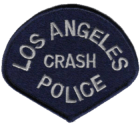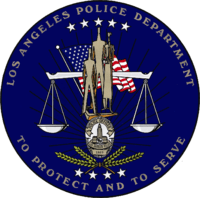Community Resources Against Street Hoodlums
The Community Resources Against Street Hoodlums (CRASH) was a specialized unit of the Los Angeles Police Department (LAPD) tasked with combating gang-related crime from 1979 to 2000. CRASH was established in South Central in 1979, to combat the rising problem of gangs in Los Angeles, California. Each of the LAPD's 18 divisions had a CRASH unit assigned to it, whose primary goal was to suppress the influx of gang-related crimes in Los Angeles, which came about primarily from the increase in illegal drug trade.[1][2]
| Community Resources Against Street Hoodlums | |
|---|---|
 Patch of the Los Angeles Police Department CRASH division | |
| Abbreviation | CRASH |
| Motto | "To Protect and to Serve" "We Intimidate Those Who Intimidate Others" (unofficial) |
| Agency overview | |
| Formed | 1979 |
| Dissolved | March 2000 |
| Superseding agency | LAPD Gang and Narcotics Division |
| Jurisdictional structure | |
| Operations jurisdiction | Los Angeles, California, U.S. |
| Size | 498 sq mi (1,290 km2) |
| Population | 3.8 million |
| Operational structure | |
| Officers | 300 (estimated) |
| Parent agency | Los Angeles Police Department |
| Facilities | |
| Areas | 18
|
CRASH was subject of the Rampart scandal from 1997 which exposed widespread police corruption within the unit, including involvement in murders, robberies, police brutality, evidence planting, and participating in gang activity. CRASH was disbanded in 2000, and was replaced by the LAPD Gang and Narcotics Division.
History
Establishment
By 1973, street gangs were quickly becoming a problem in the 77th Street Division of the Los Angeles Police Department (LAPD), located in the South Central area of Los Angeles, California. Deputy Chief Lou Sporrer, commanding officer of South Bureau, responsible for 77th Street Division operations and ultimately responsible to Chief of Police Edward M. Davis, created a unit of uniformed officers and a plainclothes intelligence section. The two were combined to be identified as 77th Street Division TRASH, an acronym for "Total Resources Against Street Hoodlums" with the idea that LAPD did not want to glamorize gangs. Community activists began efforts to abolish the TRASH unit, stating the name itself hurt the image of these youths joining gangs. Sporrer agreed to a name change, with the "T" for Total becoming a "C" for Community and TRASH became CRASH. In addition to gang-related crime prevention, CRASH officers also had to obtain information about a specific gang that was assigned to them and relay that information between districts.[2] The "freedom of movement and activity" and "gung-ho" nature of CRASH officers led some of them to incite controversy among themselves and the whole CRASH unit.[3]
In the 1980s, gang violence began to increase dramatically as a result of the drug trade, specifically the introduction of crack cocaine.
Operation Hammer
Operation Hammer was a CRASH-led initiative that began in 1987 to crack down on gang violence in South Central Los Angeles. As a result of increasing gang violence and a drive-by killing resulting in the deaths of seven people, then-Chief of Police Daryl Gates responded by sending CRASH officers to arrest suspected gang members. At the height of this operation in April 1988, 1,453 people were arrested by one thousand police officers in a single weekend. While considered successful by some, this operation and the LAPD were maligned with accusations of racism; some believed that Operation Hammer heavily employed racial profiling, targeting African-American and Hispanic youths that were labelled as "urban terrorists" and "ruthless killers." However, proponents of the operation counter that it was not discriminatory as each gang member arrested had warrants for their arrests.
Rampart Division CRASH scandal
Every LAPD patrol division had a CRASH unit stationed in it. One of the most prominent CRASH units was stationed in the Rampart Division.
On February 26, 1998, Rampart CRASH officer Brian Hewitt was suspended and later stripped of his job when allegations arose of a cover-up of the beating and asphyxiation of Ismail Jiminez. Hewitt was accused of choking Jiminez in an interview room when the suspect refused to provide evidence of gang activities. When Jiminez reported his beating at a hospital, the evidence implicated Hewitt and led to his termination at a Board of Rights hearing.[4]
In August 1998, the same month that Chief Bernard Parks claimed that the Christopher Commission reforms were "essentially complete", officer Rafael Pérez, a nine-year LAPD veteran, was arrested on charges of stealing six pounds (2.7 kilograms) of cocaine from the department's Property Division. Pérez was initially tried on one count of possession of cocaine for sale, grand theft and forgery each. After a mistrial on December 7 of that year, more reports of cocaine theft by Pérez arose. In September 1999, in exchange for partial immunity from prosecution, he testified about a pattern of abuse and misconduct involving seventy CRASH officers, threatening to overturn thousands of criminal convictions.
As part of his plea bargain, Pérez implicated scores of officers from the Rampart Division's anti-gang unit, describing routinely beating gang members, planting evidence on suspects, falsifying reports and covering up unprovoked shootings.[5] As of May 2001, the Rampart investigation had brought fifty-eight officers before an internal administrative board. Of these, twelve were suspended, seven resigned, and five were terminated.[6] Perez confessed to framing Javier Ovando, an 18th Street Gang member, who was shot by Nino Durden and Perez on October 12, 1996.[7]
Disbandment
In March 2000, CRASH was disbanded after being gradually diminished following the Rampart scandal, and replaced with a similar anti-gang unit known as the LAPD Gangs and Narcotics Division. This new unit's minimum requirements for enlistment are higher than was CRASH's, requiring recruits to have a sufficiently high amount of experience and a low number of personnel complaints.[8][9] Major categories of crime offenses and attempted crimes in 2000 in Los Angeles increased over those of the previous year, when CRASH was at full staff.[10]
Kevin Starr, the State Librarian of California, wrote in his history of California in the 1990s that "CRASH ... became, in effect, the most badass gang in the city."[11]
In popular culture
A fictionalized version of C.R.A.S.H. appears as the main antagonists in the 2004 open world action-adventure video game Grand Theft Auto: San Andreas. Similar to its real-life LAPD counterpart, the LSPD C.R.A.S.H. is highly corrupt and led by Officer Eddie Pulaski and Officer Frank Tenpenny, who have ties to criminal gangs in Los Santos, San Andreas (the GTA universe's Los Angeles and California). The unit's unofficial motto ("We intimidate those who intimidate others") is explicitly used by Officer Tenpenny with protagonist Carl Johnson.
1988 movie Colors directed by Dennis Hopper and starring Robert Duval and Sean Penn, portrayed LAPD C.R.A.S.H. officers.
Although corruption in L.A.'s C.R.A.S.H. unit had yet to be exposed when Training Day was written, Antoine Fuqua has stated that the emergence of the Rampart Scandal in the late 1990s catalyzed the completion of the film. Denzel Washington also grew a beard in order to emulate the appearance of Rafael Pérez, an LAPD narcotics officer involved in multiple scandals.[12] [13]
The Police drama series The Shield (2002-2008) about a corrupt anti-gang unit called the Strike Team, is based on the Rampart scandal. Rampart was the original name for the show.
See also
References
- "Gangs: Additional Resources". Los Angeles Police Department. Retrieved 2006-06-26.
- "CRASH Culture". PBS Frontline. Retrieved 2006-06-26.
- "Interviews: Gerald Chaleff". PBS Frontline. Retrieved 2006-06-26.
- GLOVER, SCOTT; LAIT, MATT (14 February 2000). "Beatings Alleged to Be Routine at Rampart" – via LA Times.
- "Ex-Chief Refuses to Discuss Rampart". www.latimes.com.
- "Rampart Scandal - Cover Up? - PBS - L.a.p.d. Blues - FRONTLINE - PBS". www.pbs.org.
- Cannon, Lou. "One Bad Cop".
- "LAPD's Anti-Gang Unit is Disbanded Following Widespread Corruption Scandal". CNN. 2000-03-12. Retrieved 2006-06-26.
- "Rampart Scandal Timeline". PBS Frontline. Retrieved 2006-06-26.
- "Crime Statistics - Year 2000" (PDF). Los Angeles Police Department. p. 2. Retrieved 2006-06-26.
- Kevin Starr, Coast of Dreams: California On The Edge, 1990-2003 (New York: Alfred A. Knopf, 2004), 92.
- Murray Pomerance (February 1, 2012). Bad: Infamy, Darkness, Evil and Slime on Screen. SUNY Press.
- Jonathan Markovitz (October 14, 2011). Racial Spectacles:Explorations in Media, Race and Justice. Taylor & Francis.
